Enterprise Architecture: Benefits, Frameworks, and Impact
VerifiedAdded on 2021/06/05
|12
|3571
|124
Essay
AI Summary
This essay provides a comprehensive overview of enterprise architecture, examining its core concepts, benefits, and challenges. It begins by defining enterprise architecture and its role in aligning IT strategies with business goals. The essay then delves into a literature review, exploring the benefits such as improved strategic advantage, reduced risk, and cost-effectiveness, alongside challenges like lack of management commitment. The essay further analyzes various enterprise architecture frameworks, including TOGAF, Zachman Framework, and ArchiMate, detailing their structures and applications. The impact of enterprise architecture on organizational success is discussed, followed by a conclusion summarizing the key findings, limitations, and potential future trends in the field. The essay highlights how enterprise architecture facilitates digital transformation, enhances IT governance, and supports strategic decision-making within organizations.
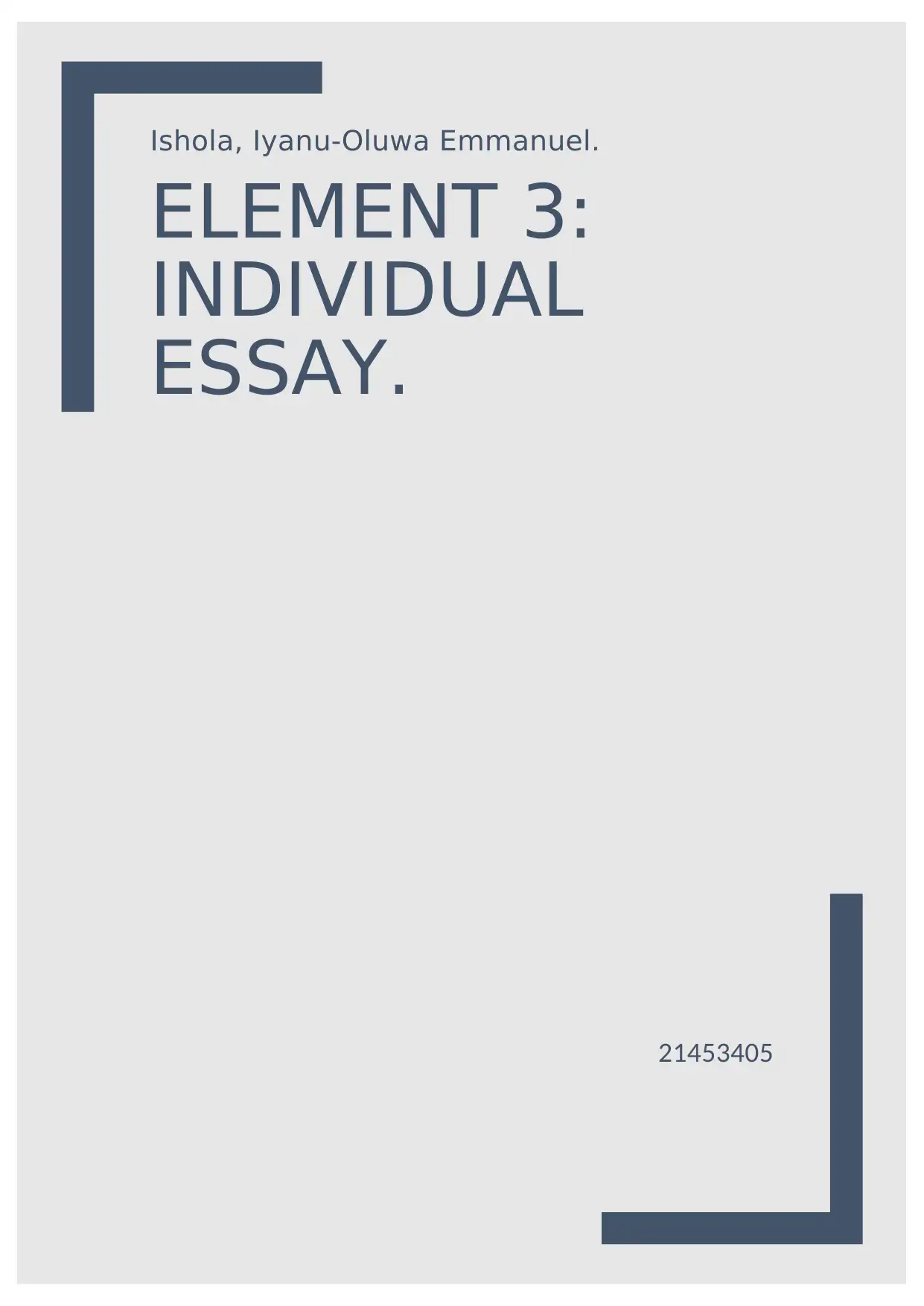
Ishola, Iyanu-Oluwa Emmanuel.
ELEMENT 3:
INDIVIDUAL
ESSAY.
21453405
ELEMENT 3:
INDIVIDUAL
ESSAY.
21453405
Paraphrase This Document
Need a fresh take? Get an instant paraphrase of this document with our AI Paraphraser
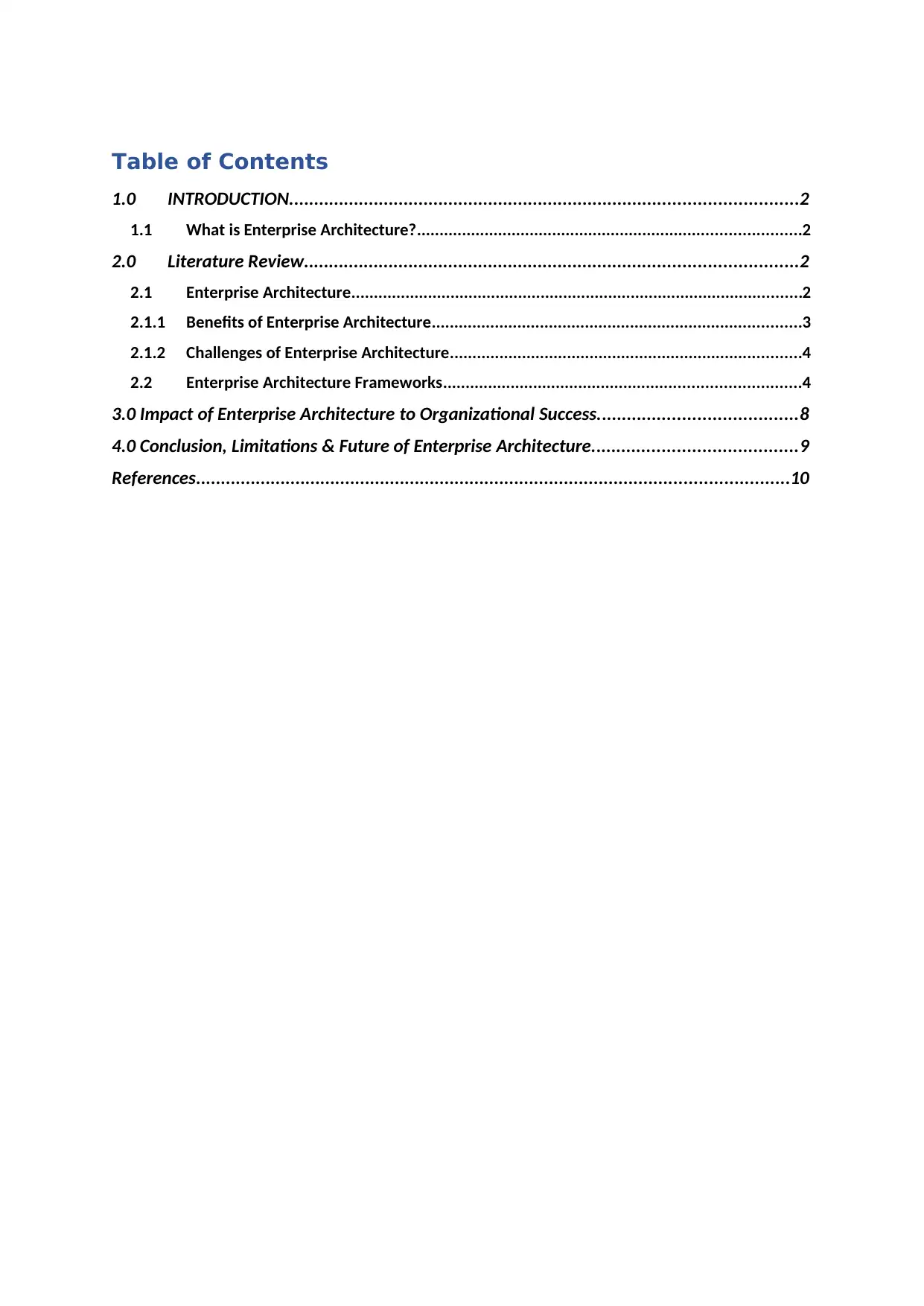
Table of Contents
1.0 INTRODUCTION......................................................................................................2
1.1 What is Enterprise Architecture?.....................................................................................2
2.0 Literature Review...................................................................................................2
2.1 Enterprise Architecture....................................................................................................2
2.1.1 Benefits of Enterprise Architecture..................................................................................3
2.1.2 Challenges of Enterprise Architecture..............................................................................4
2.2 Enterprise Architecture Frameworks...............................................................................4
3.0 Impact of Enterprise Architecture to Organizational Success........................................8
4.0 Conclusion, Limitations & Future of Enterprise Architecture.........................................9
References.......................................................................................................................10
1.0 INTRODUCTION......................................................................................................2
1.1 What is Enterprise Architecture?.....................................................................................2
2.0 Literature Review...................................................................................................2
2.1 Enterprise Architecture....................................................................................................2
2.1.1 Benefits of Enterprise Architecture..................................................................................3
2.1.2 Challenges of Enterprise Architecture..............................................................................4
2.2 Enterprise Architecture Frameworks...............................................................................4
3.0 Impact of Enterprise Architecture to Organizational Success........................................8
4.0 Conclusion, Limitations & Future of Enterprise Architecture.........................................9
References.......................................................................................................................10
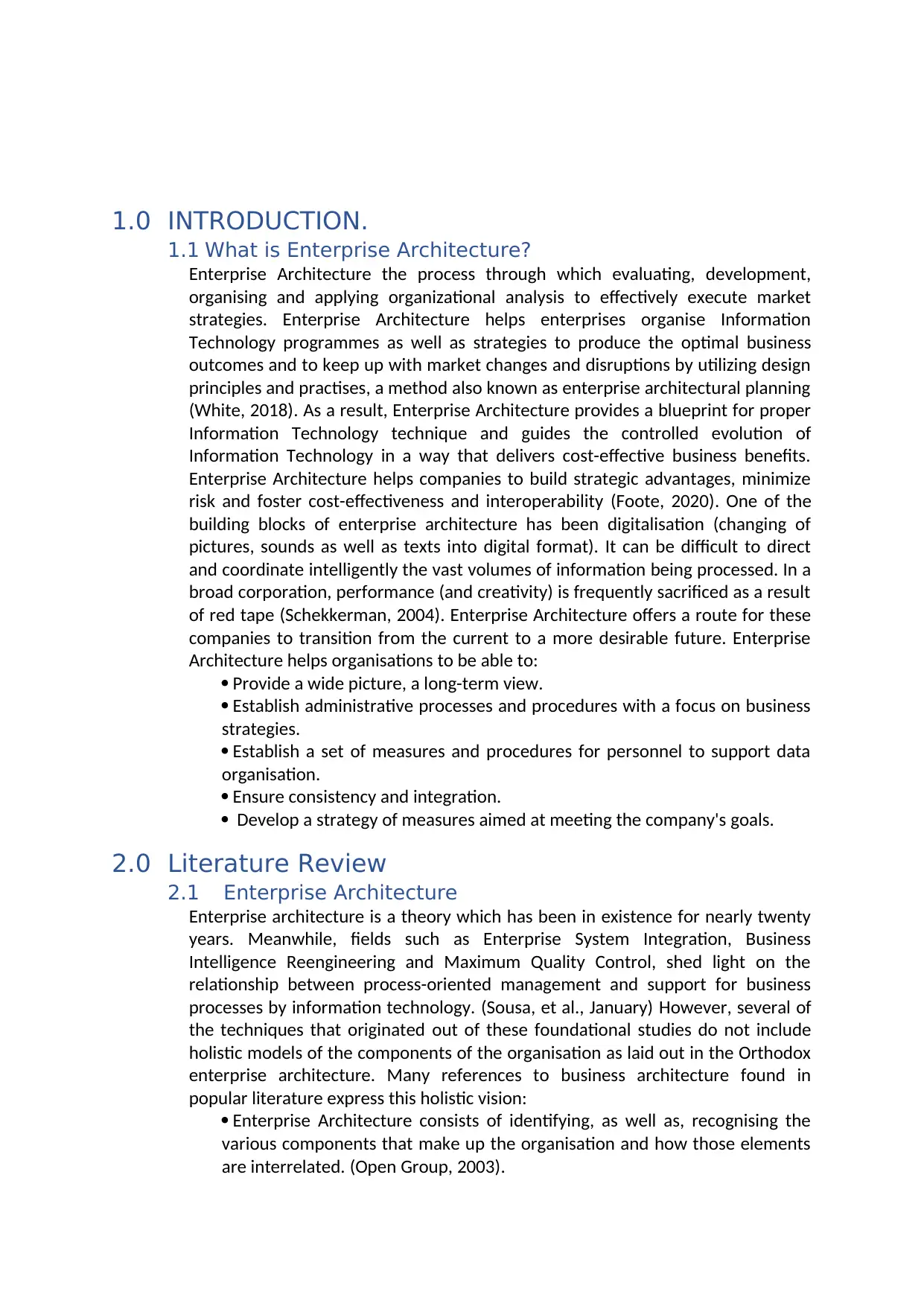
1.0 INTRODUCTION.
1.1 What is Enterprise Architecture?
Enterprise Architecture the process through which evaluating, development,
organising and applying organizational analysis to effectively execute market
strategies. Enterprise Architecture helps enterprises organise Information
Technology programmes as well as strategies to produce the optimal business
outcomes and to keep up with market changes and disruptions by utilizing design
principles and practises, a method also known as enterprise architectural planning
(White, 2018). As a result, Enterprise Architecture provides a blueprint for proper
Information Technology technique and guides the controlled evolution of
Information Technology in a way that delivers cost-effective business benefits.
Enterprise Architecture helps companies to build strategic advantages, minimize
risk and foster cost-effectiveness and interoperability (Foote, 2020). One of the
building blocks of enterprise architecture has been digitalisation (changing of
pictures, sounds as well as texts into digital format). It can be difficult to direct
and coordinate intelligently the vast volumes of information being processed. In a
broad corporation, performance (and creativity) is frequently sacrificed as a result
of red tape (Schekkerman, 2004). Enterprise Architecture offers a route for these
companies to transition from the current to a more desirable future. Enterprise
Architecture helps organisations to be able to:
Provide a wide picture, a long-term view.
Establish administrative processes and procedures with a focus on business
strategies.
Establish a set of measures and procedures for personnel to support data
organisation.
Ensure consistency and integration.
Develop a strategy of measures aimed at meeting the company's goals.
2.0 Literature Review
2.1 Enterprise Architecture
Enterprise architecture is a theory which has been in existence for nearly twenty
years. Meanwhile, fields such as Enterprise System Integration, Business
Intelligence Reengineering and Maximum Quality Control, shed light on the
relationship between process-oriented management and support for business
processes by information technology. (Sousa, et al., January) However, several of
the techniques that originated out of these foundational studies do not include
holistic models of the components of the organisation as laid out in the Orthodox
enterprise architecture. Many references to business architecture found in
popular literature express this holistic vision:
Enterprise Architecture consists of identifying, as well as, recognising the
various components that make up the organisation and how those elements
are interrelated. (Open Group, 2003).
1.1 What is Enterprise Architecture?
Enterprise Architecture the process through which evaluating, development,
organising and applying organizational analysis to effectively execute market
strategies. Enterprise Architecture helps enterprises organise Information
Technology programmes as well as strategies to produce the optimal business
outcomes and to keep up with market changes and disruptions by utilizing design
principles and practises, a method also known as enterprise architectural planning
(White, 2018). As a result, Enterprise Architecture provides a blueprint for proper
Information Technology technique and guides the controlled evolution of
Information Technology in a way that delivers cost-effective business benefits.
Enterprise Architecture helps companies to build strategic advantages, minimize
risk and foster cost-effectiveness and interoperability (Foote, 2020). One of the
building blocks of enterprise architecture has been digitalisation (changing of
pictures, sounds as well as texts into digital format). It can be difficult to direct
and coordinate intelligently the vast volumes of information being processed. In a
broad corporation, performance (and creativity) is frequently sacrificed as a result
of red tape (Schekkerman, 2004). Enterprise Architecture offers a route for these
companies to transition from the current to a more desirable future. Enterprise
Architecture helps organisations to be able to:
Provide a wide picture, a long-term view.
Establish administrative processes and procedures with a focus on business
strategies.
Establish a set of measures and procedures for personnel to support data
organisation.
Ensure consistency and integration.
Develop a strategy of measures aimed at meeting the company's goals.
2.0 Literature Review
2.1 Enterprise Architecture
Enterprise architecture is a theory which has been in existence for nearly twenty
years. Meanwhile, fields such as Enterprise System Integration, Business
Intelligence Reengineering and Maximum Quality Control, shed light on the
relationship between process-oriented management and support for business
processes by information technology. (Sousa, et al., January) However, several of
the techniques that originated out of these foundational studies do not include
holistic models of the components of the organisation as laid out in the Orthodox
enterprise architecture. Many references to business architecture found in
popular literature express this holistic vision:
Enterprise Architecture consists of identifying, as well as, recognising the
various components that make up the organisation and how those elements
are interrelated. (Open Group, 2003).
⊘ This is a preview!⊘
Do you want full access?
Subscribe today to unlock all pages.

Trusted by 1+ million students worldwide
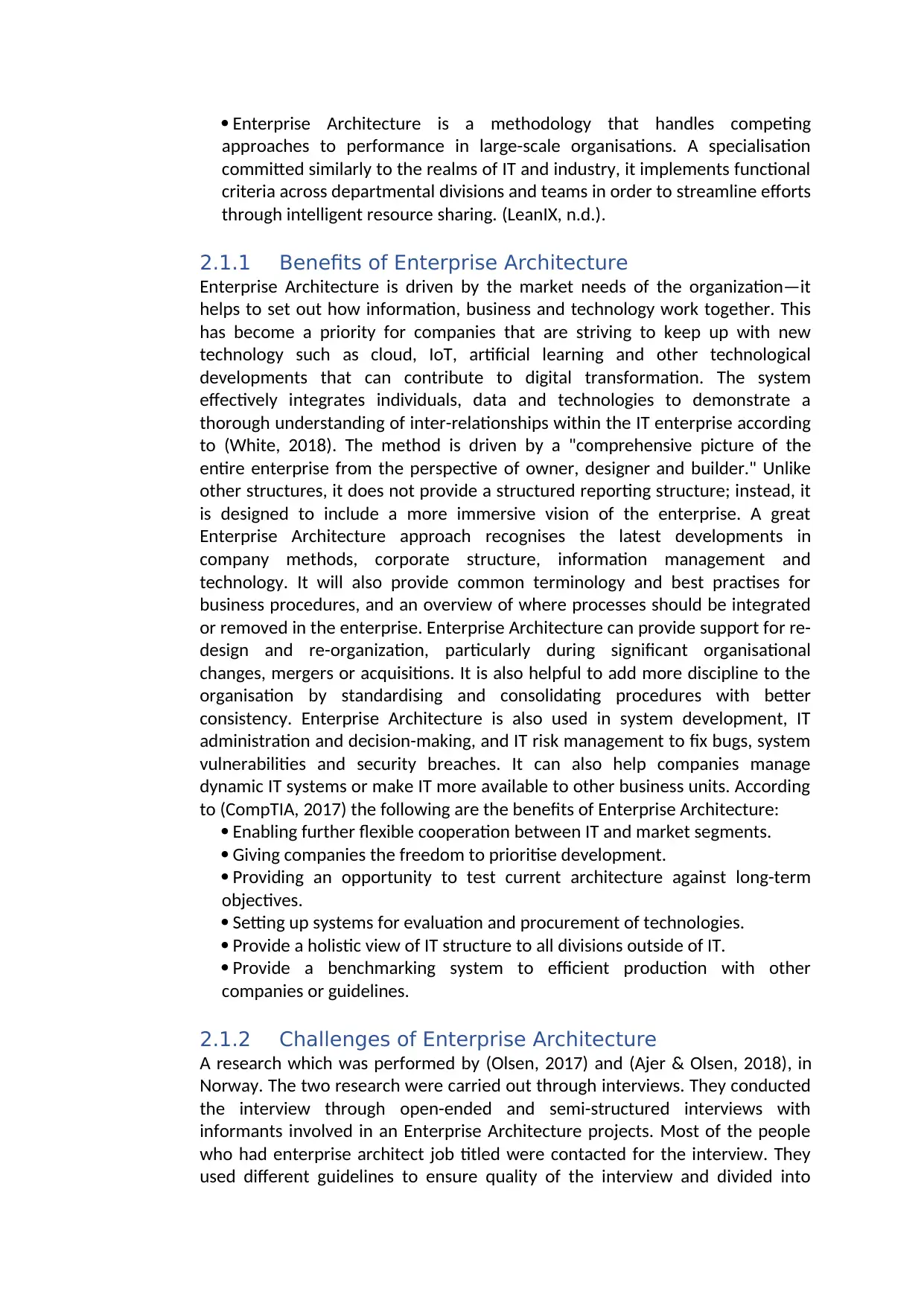
Enterprise Architecture is a methodology that handles competing
approaches to performance in large-scale organisations. A specialisation
committed similarly to the realms of IT and industry, it implements functional
criteria across departmental divisions and teams in order to streamline efforts
through intelligent resource sharing. (LeanIX, n.d.).
2.1.1 Benefits of Enterprise Architecture
Enterprise Architecture is driven by the market needs of the organization—it
helps to set out how information, business and technology work together. This
has become a priority for companies that are striving to keep up with new
technology such as cloud, IoT, artificial learning and other technological
developments that can contribute to digital transformation. The system
effectively integrates individuals, data and technologies to demonstrate a
thorough understanding of inter-relationships within the IT enterprise according
to (White, 2018). The method is driven by a "comprehensive picture of the
entire enterprise from the perspective of owner, designer and builder." Unlike
other structures, it does not provide a structured reporting structure; instead, it
is designed to include a more immersive vision of the enterprise. A great
Enterprise Architecture approach recognises the latest developments in
company methods, corporate structure, information management and
technology. It will also provide common terminology and best practises for
business procedures, and an overview of where processes should be integrated
or removed in the enterprise. Enterprise Architecture can provide support for re-
design and re-organization, particularly during significant organisational
changes, mergers or acquisitions. It is also helpful to add more discipline to the
organisation by standardising and consolidating procedures with better
consistency. Enterprise Architecture is also used in system development, IT
administration and decision-making, and IT risk management to fix bugs, system
vulnerabilities and security breaches. It can also help companies manage
dynamic IT systems or make IT more available to other business units. According
to (CompTIA, 2017) the following are the benefits of Enterprise Architecture:
Enabling further flexible cooperation between IT and market segments.
Giving companies the freedom to prioritise development.
Providing an opportunity to test current architecture against long-term
objectives.
Setting up systems for evaluation and procurement of technologies.
Provide a holistic view of IT structure to all divisions outside of IT.
Provide a benchmarking system to efficient production with other
companies or guidelines.
2.1.2 Challenges of Enterprise Architecture
A research which was performed by (Olsen, 2017) and (Ajer & Olsen, 2018), in
Norway. The two research were carried out through interviews. They conducted
the interview through open-ended and semi-structured interviews with
informants involved in an Enterprise Architecture projects. Most of the people
who had enterprise architect job titled were contacted for the interview. They
used different guidelines to ensure quality of the interview and divided into
approaches to performance in large-scale organisations. A specialisation
committed similarly to the realms of IT and industry, it implements functional
criteria across departmental divisions and teams in order to streamline efforts
through intelligent resource sharing. (LeanIX, n.d.).
2.1.1 Benefits of Enterprise Architecture
Enterprise Architecture is driven by the market needs of the organization—it
helps to set out how information, business and technology work together. This
has become a priority for companies that are striving to keep up with new
technology such as cloud, IoT, artificial learning and other technological
developments that can contribute to digital transformation. The system
effectively integrates individuals, data and technologies to demonstrate a
thorough understanding of inter-relationships within the IT enterprise according
to (White, 2018). The method is driven by a "comprehensive picture of the
entire enterprise from the perspective of owner, designer and builder." Unlike
other structures, it does not provide a structured reporting structure; instead, it
is designed to include a more immersive vision of the enterprise. A great
Enterprise Architecture approach recognises the latest developments in
company methods, corporate structure, information management and
technology. It will also provide common terminology and best practises for
business procedures, and an overview of where processes should be integrated
or removed in the enterprise. Enterprise Architecture can provide support for re-
design and re-organization, particularly during significant organisational
changes, mergers or acquisitions. It is also helpful to add more discipline to the
organisation by standardising and consolidating procedures with better
consistency. Enterprise Architecture is also used in system development, IT
administration and decision-making, and IT risk management to fix bugs, system
vulnerabilities and security breaches. It can also help companies manage
dynamic IT systems or make IT more available to other business units. According
to (CompTIA, 2017) the following are the benefits of Enterprise Architecture:
Enabling further flexible cooperation between IT and market segments.
Giving companies the freedom to prioritise development.
Providing an opportunity to test current architecture against long-term
objectives.
Setting up systems for evaluation and procurement of technologies.
Provide a holistic view of IT structure to all divisions outside of IT.
Provide a benchmarking system to efficient production with other
companies or guidelines.
2.1.2 Challenges of Enterprise Architecture
A research which was performed by (Olsen, 2017) and (Ajer & Olsen, 2018), in
Norway. The two research were carried out through interviews. They conducted
the interview through open-ended and semi-structured interviews with
informants involved in an Enterprise Architecture projects. Most of the people
who had enterprise architect job titled were contacted for the interview. They
used different guidelines to ensure quality of the interview and divided into
Paraphrase This Document
Need a fresh take? Get an instant paraphrase of this document with our AI Paraphraser
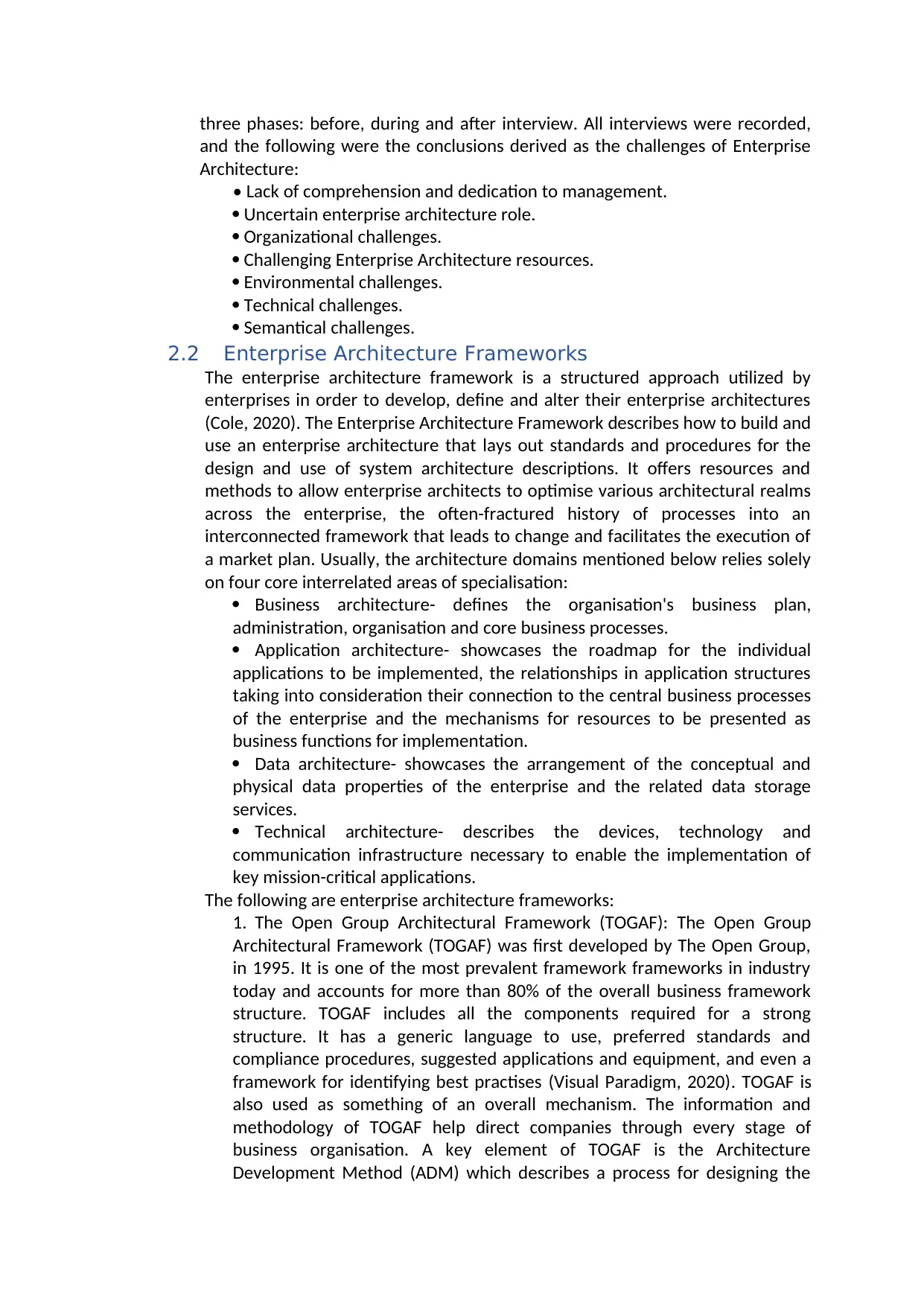
three phases: before, during and after interview. All interviews were recorded,
and the following were the conclusions derived as the challenges of Enterprise
Architecture:
• Lack of comprehension and dedication to management.
Uncertain enterprise architecture role.
Organizational challenges.
Challenging Enterprise Architecture resources.
Environmental challenges.
Technical challenges.
Semantical challenges.
2.2 Enterprise Architecture Frameworks
The enterprise architecture framework is a structured approach utilized by
enterprises in order to develop, define and alter their enterprise architectures
(Cole, 2020). The Enterprise Architecture Framework describes how to build and
use an enterprise architecture that lays out standards and procedures for the
design and use of system architecture descriptions. It offers resources and
methods to allow enterprise architects to optimise various architectural realms
across the enterprise, the often-fractured history of processes into an
interconnected framework that leads to change and facilitates the execution of
a market plan. Usually, the architecture domains mentioned below relies solely
on four core interrelated areas of specialisation:
Business architecture- defines the organisation's business plan,
administration, organisation and core business processes.
Application architecture- showcases the roadmap for the individual
applications to be implemented, the relationships in application structures
taking into consideration their connection to the central business processes
of the enterprise and the mechanisms for resources to be presented as
business functions for implementation.
Data architecture- showcases the arrangement of the conceptual and
physical data properties of the enterprise and the related data storage
services.
Technical architecture- describes the devices, technology and
communication infrastructure necessary to enable the implementation of
key mission-critical applications.
The following are enterprise architecture frameworks:
1. The Open Group Architectural Framework (TOGAF): The Open Group
Architectural Framework (TOGAF) was first developed by The Open Group,
in 1995. It is one of the most prevalent framework frameworks in industry
today and accounts for more than 80% of the overall business framework
structure. TOGAF includes all the components required for a strong
structure. It has a generic language to use, preferred standards and
compliance procedures, suggested applications and equipment, and even a
framework for identifying best practises (Visual Paradigm, 2020). TOGAF is
also used as something of an overall mechanism. The information and
methodology of TOGAF help direct companies through every stage of
business organisation. A key element of TOGAF is the Architecture
Development Method (ADM) which describes a process for designing the
and the following were the conclusions derived as the challenges of Enterprise
Architecture:
• Lack of comprehension and dedication to management.
Uncertain enterprise architecture role.
Organizational challenges.
Challenging Enterprise Architecture resources.
Environmental challenges.
Technical challenges.
Semantical challenges.
2.2 Enterprise Architecture Frameworks
The enterprise architecture framework is a structured approach utilized by
enterprises in order to develop, define and alter their enterprise architectures
(Cole, 2020). The Enterprise Architecture Framework describes how to build and
use an enterprise architecture that lays out standards and procedures for the
design and use of system architecture descriptions. It offers resources and
methods to allow enterprise architects to optimise various architectural realms
across the enterprise, the often-fractured history of processes into an
interconnected framework that leads to change and facilitates the execution of
a market plan. Usually, the architecture domains mentioned below relies solely
on four core interrelated areas of specialisation:
Business architecture- defines the organisation's business plan,
administration, organisation and core business processes.
Application architecture- showcases the roadmap for the individual
applications to be implemented, the relationships in application structures
taking into consideration their connection to the central business processes
of the enterprise and the mechanisms for resources to be presented as
business functions for implementation.
Data architecture- showcases the arrangement of the conceptual and
physical data properties of the enterprise and the related data storage
services.
Technical architecture- describes the devices, technology and
communication infrastructure necessary to enable the implementation of
key mission-critical applications.
The following are enterprise architecture frameworks:
1. The Open Group Architectural Framework (TOGAF): The Open Group
Architectural Framework (TOGAF) was first developed by The Open Group,
in 1995. It is one of the most prevalent framework frameworks in industry
today and accounts for more than 80% of the overall business framework
structure. TOGAF includes all the components required for a strong
structure. It has a generic language to use, preferred standards and
compliance procedures, suggested applications and equipment, and even a
framework for identifying best practises (Visual Paradigm, 2020). TOGAF is
also used as something of an overall mechanism. The information and
methodology of TOGAF help direct companies through every stage of
business organisation. A key element of TOGAF is the Architecture
Development Method (ADM) which describes a process for designing the
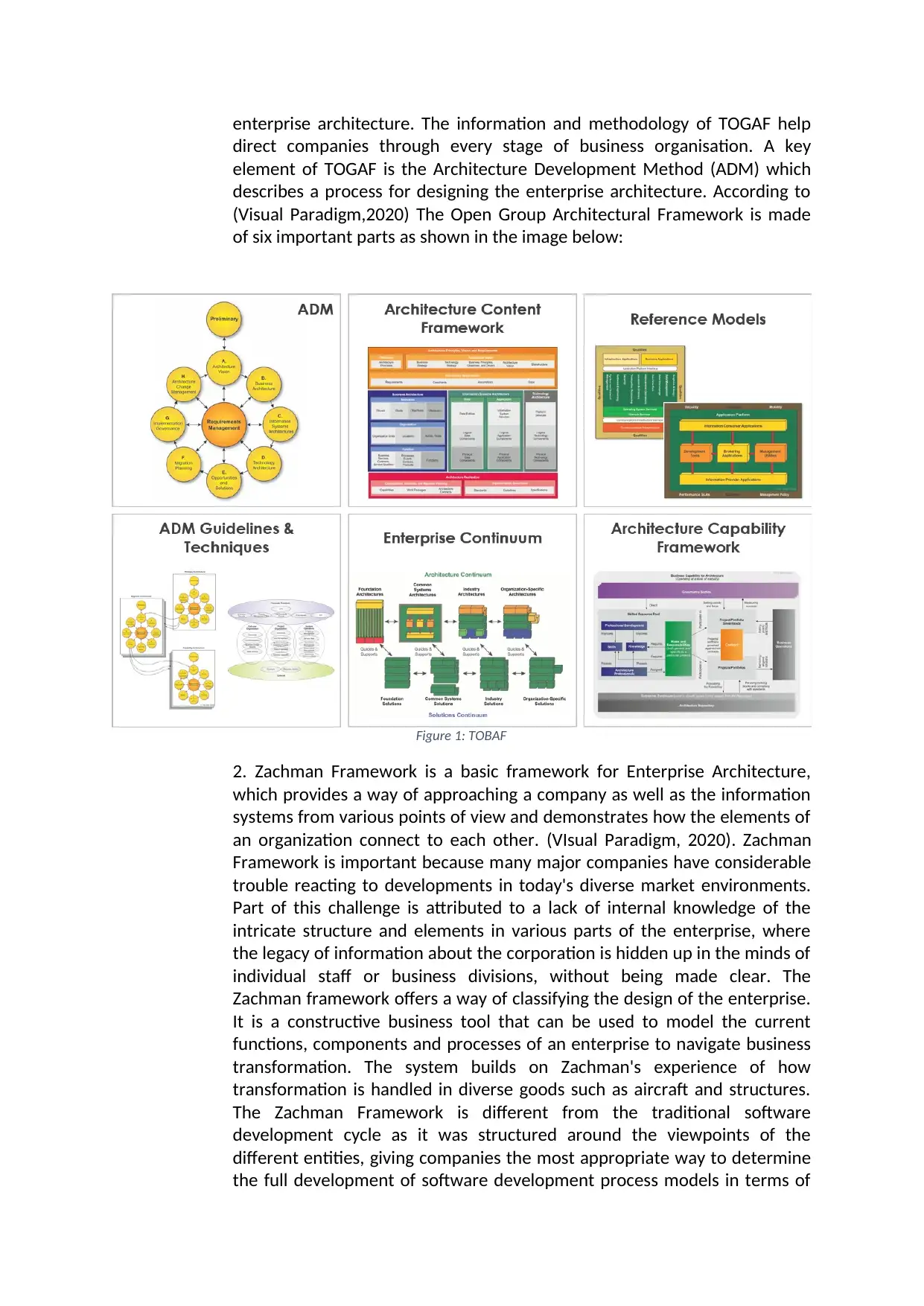
enterprise architecture. The information and methodology of TOGAF help
direct companies through every stage of business organisation. A key
element of TOGAF is the Architecture Development Method (ADM) which
describes a process for designing the enterprise architecture. According to
(Visual Paradigm,2020) The Open Group Architectural Framework is made
of six important parts as shown in the image below:
Figure 1: TOBAF
2. Zachman Framework is a basic framework for Enterprise Architecture,
which provides a way of approaching a company as well as the information
systems from various points of view and demonstrates how the elements of
an organization connect to each other. (VIsual Paradigm, 2020). Zachman
Framework is important because many major companies have considerable
trouble reacting to developments in today's diverse market environments.
Part of this challenge is attributed to a lack of internal knowledge of the
intricate structure and elements in various parts of the enterprise, where
the legacy of information about the corporation is hidden up in the minds of
individual staff or business divisions, without being made clear. The
Zachman framework offers a way of classifying the design of the enterprise.
It is a constructive business tool that can be used to model the current
functions, components and processes of an enterprise to navigate business
transformation. The system builds on Zachman's experience of how
transformation is handled in diverse goods such as aircraft and structures.
The Zachman Framework is different from the traditional software
development cycle as it was structured around the viewpoints of the
different entities, giving companies the most appropriate way to determine
the full development of software development process models in terms of
direct companies through every stage of business organisation. A key
element of TOGAF is the Architecture Development Method (ADM) which
describes a process for designing the enterprise architecture. According to
(Visual Paradigm,2020) The Open Group Architectural Framework is made
of six important parts as shown in the image below:
Figure 1: TOBAF
2. Zachman Framework is a basic framework for Enterprise Architecture,
which provides a way of approaching a company as well as the information
systems from various points of view and demonstrates how the elements of
an organization connect to each other. (VIsual Paradigm, 2020). Zachman
Framework is important because many major companies have considerable
trouble reacting to developments in today's diverse market environments.
Part of this challenge is attributed to a lack of internal knowledge of the
intricate structure and elements in various parts of the enterprise, where
the legacy of information about the corporation is hidden up in the minds of
individual staff or business divisions, without being made clear. The
Zachman framework offers a way of classifying the design of the enterprise.
It is a constructive business tool that can be used to model the current
functions, components and processes of an enterprise to navigate business
transformation. The system builds on Zachman's experience of how
transformation is handled in diverse goods such as aircraft and structures.
The Zachman Framework is different from the traditional software
development cycle as it was structured around the viewpoints of the
different entities, giving companies the most appropriate way to determine
the full development of software development process models in terms of
⊘ This is a preview!⊘
Do you want full access?
Subscribe today to unlock all pages.

Trusted by 1+ million students worldwide
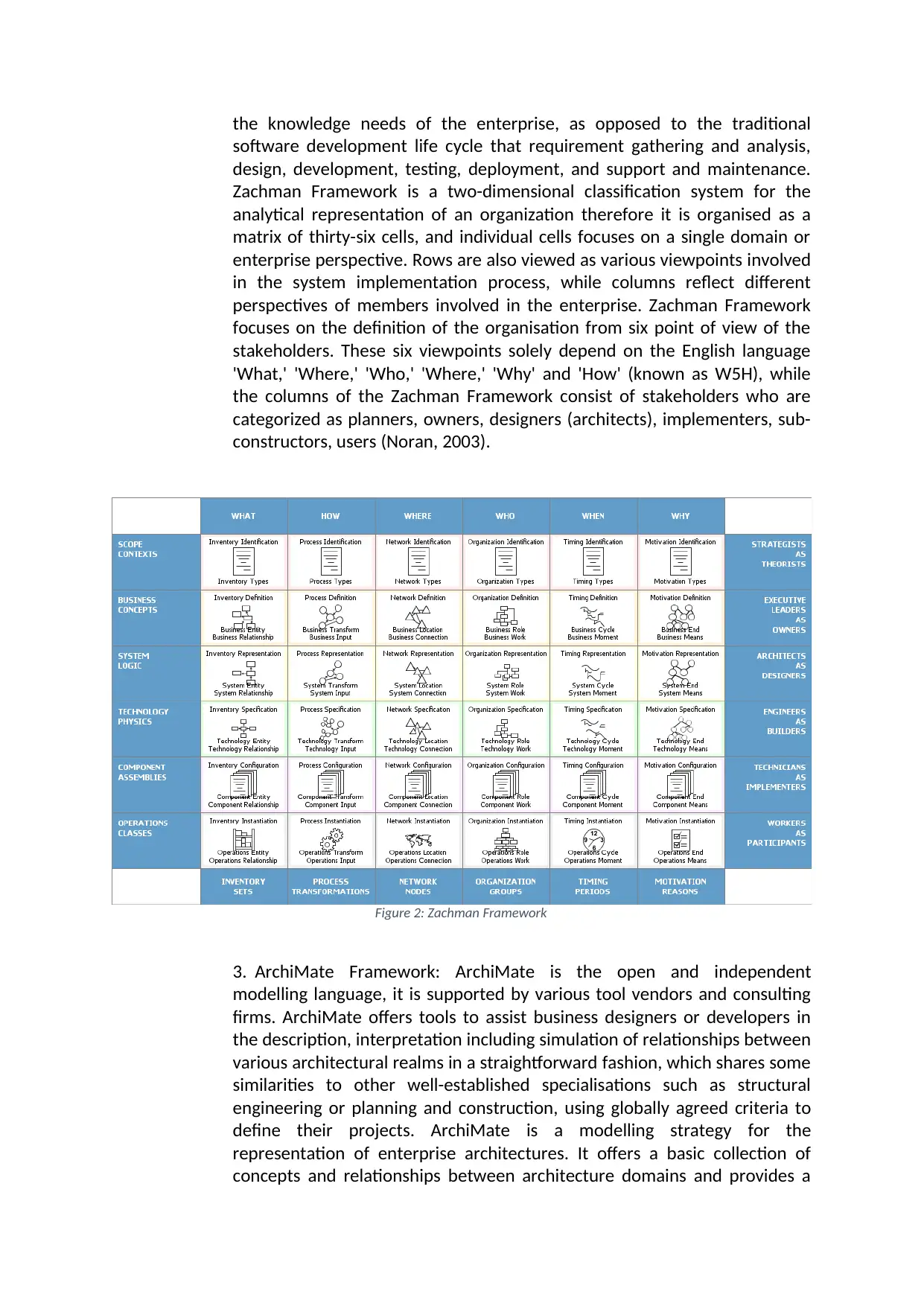
the knowledge needs of the enterprise, as opposed to the traditional
software development life cycle that requirement gathering and analysis,
design, development, testing, deployment, and support and maintenance.
Zachman Framework is a two-dimensional classification system for the
analytical representation of an organization therefore it is organised as a
matrix of thirty-six cells, and individual cells focuses on a single domain or
enterprise perspective. Rows are also viewed as various viewpoints involved
in the system implementation process, while columns reflect different
perspectives of members involved in the enterprise. Zachman Framework
focuses on the definition of the organisation from six point of view of the
stakeholders. These six viewpoints solely depend on the English language
'What,' 'Where,' 'Who,' 'Where,' 'Why' and 'How' (known as W5H), while
the columns of the Zachman Framework consist of stakeholders who are
categorized as planners, owners, designers (architects), implementers, sub-
constructors, users (Noran, 2003).
Figure 2: Zachman Framework
3. ArchiMate Framework: ArchiMate is the open and independent
modelling language, it is supported by various tool vendors and consulting
firms. ArchiMate offers tools to assist business designers or developers in
the description, interpretation including simulation of relationships between
various architectural realms in a straightforward fashion, which shares some
similarities to other well-established specialisations such as structural
engineering or planning and construction, using globally agreed criteria to
define their projects. ArchiMate is a modelling strategy for the
representation of enterprise architectures. It offers a basic collection of
concepts and relationships between architecture domains and provides a
software development life cycle that requirement gathering and analysis,
design, development, testing, deployment, and support and maintenance.
Zachman Framework is a two-dimensional classification system for the
analytical representation of an organization therefore it is organised as a
matrix of thirty-six cells, and individual cells focuses on a single domain or
enterprise perspective. Rows are also viewed as various viewpoints involved
in the system implementation process, while columns reflect different
perspectives of members involved in the enterprise. Zachman Framework
focuses on the definition of the organisation from six point of view of the
stakeholders. These six viewpoints solely depend on the English language
'What,' 'Where,' 'Who,' 'Where,' 'Why' and 'How' (known as W5H), while
the columns of the Zachman Framework consist of stakeholders who are
categorized as planners, owners, designers (architects), implementers, sub-
constructors, users (Noran, 2003).
Figure 2: Zachman Framework
3. ArchiMate Framework: ArchiMate is the open and independent
modelling language, it is supported by various tool vendors and consulting
firms. ArchiMate offers tools to assist business designers or developers in
the description, interpretation including simulation of relationships between
various architectural realms in a straightforward fashion, which shares some
similarities to other well-established specialisations such as structural
engineering or planning and construction, using globally agreed criteria to
define their projects. ArchiMate is a modelling strategy for the
representation of enterprise architectures. It offers a basic collection of
concepts and relationships between architecture domains and provides a
Paraphrase This Document
Need a fresh take? Get an instant paraphrase of this document with our AI Paraphraser

simple and coherent framework for the definition of the contents of these
domains. Much as an architectural sketch of classical building design
explains the different facets of the design and operation of the building.
ArchiMate is useful when for: Business processes, Organizational structures,
Information flows, IT systems, Technical infrastructure. ArchiMate
Framework is divided into layers and aspects, which then divides the
enterprise into business, application and technology layer. In each layer,
there are three different aspects (active structure aspect, behaviour aspect
and passive structure aspect). This is shown in figure 3 below.
Figure 3: Simplified ArchiMate Framework
The full ArchiMate vocabulary introduces a variety of layers as well as an
element to the main structure. Physical components are applied to the
Technology Layer for the simulation of physical structures as well as
machinery, storage networks and materials. In addition, an extra motivating
component and the deployment and migration components are added. The
resulting complete ArchiMate structure is evident in the image below.
domains. Much as an architectural sketch of classical building design
explains the different facets of the design and operation of the building.
ArchiMate is useful when for: Business processes, Organizational structures,
Information flows, IT systems, Technical infrastructure. ArchiMate
Framework is divided into layers and aspects, which then divides the
enterprise into business, application and technology layer. In each layer,
there are three different aspects (active structure aspect, behaviour aspect
and passive structure aspect). This is shown in figure 3 below.
Figure 3: Simplified ArchiMate Framework
The full ArchiMate vocabulary introduces a variety of layers as well as an
element to the main structure. Physical components are applied to the
Technology Layer for the simulation of physical structures as well as
machinery, storage networks and materials. In addition, an extra motivating
component and the deployment and migration components are added. The
resulting complete ArchiMate structure is evident in the image below.
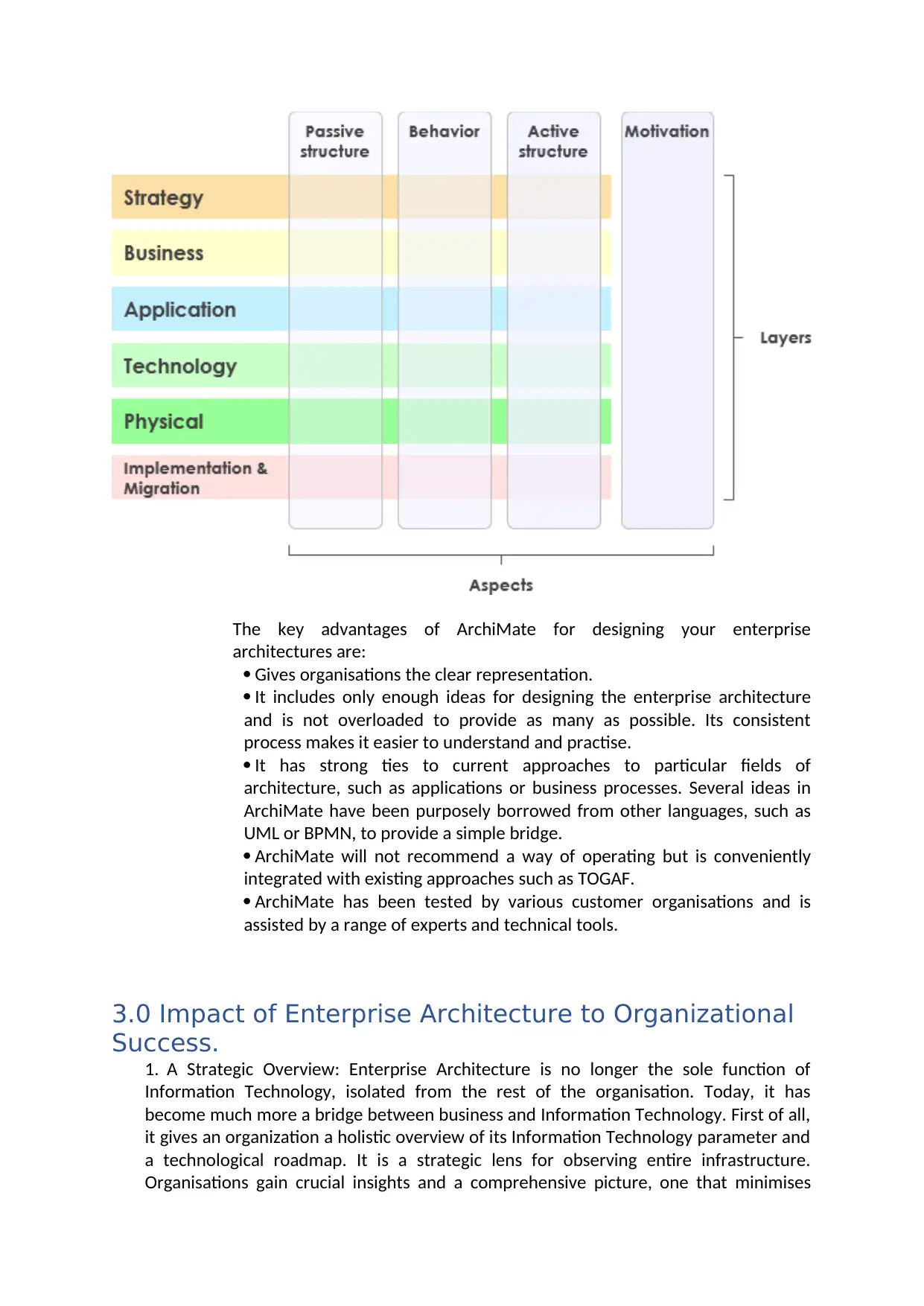
The key advantages of ArchiMate for designing your enterprise
architectures are:
Gives organisations the clear representation.
It includes only enough ideas for designing the enterprise architecture
and is not overloaded to provide as many as possible. Its consistent
process makes it easier to understand and practise.
It has strong ties to current approaches to particular fields of
architecture, such as applications or business processes. Several ideas in
ArchiMate have been purposely borrowed from other languages, such as
UML or BPMN, to provide a simple bridge.
ArchiMate will not recommend a way of operating but is conveniently
integrated with existing approaches such as TOGAF.
ArchiMate has been tested by various customer organisations and is
assisted by a range of experts and technical tools.
3.0 Impact of Enterprise Architecture to Organizational
Success.
1. A Strategic Overview: Enterprise Architecture is no longer the sole function of
Information Technology, isolated from the rest of the organisation. Today, it has
become much more a bridge between business and Information Technology. First of all,
it gives an organization a holistic overview of its Information Technology parameter and
a technological roadmap. It is a strategic lens for observing entire infrastructure.
Organisations gain crucial insights and a comprehensive picture, one that minimises
architectures are:
Gives organisations the clear representation.
It includes only enough ideas for designing the enterprise architecture
and is not overloaded to provide as many as possible. Its consistent
process makes it easier to understand and practise.
It has strong ties to current approaches to particular fields of
architecture, such as applications or business processes. Several ideas in
ArchiMate have been purposely borrowed from other languages, such as
UML or BPMN, to provide a simple bridge.
ArchiMate will not recommend a way of operating but is conveniently
integrated with existing approaches such as TOGAF.
ArchiMate has been tested by various customer organisations and is
assisted by a range of experts and technical tools.
3.0 Impact of Enterprise Architecture to Organizational
Success.
1. A Strategic Overview: Enterprise Architecture is no longer the sole function of
Information Technology, isolated from the rest of the organisation. Today, it has
become much more a bridge between business and Information Technology. First of all,
it gives an organization a holistic overview of its Information Technology parameter and
a technological roadmap. It is a strategic lens for observing entire infrastructure.
Organisations gain crucial insights and a comprehensive picture, one that minimises
⊘ This is a preview!⊘
Do you want full access?
Subscribe today to unlock all pages.

Trusted by 1+ million students worldwide
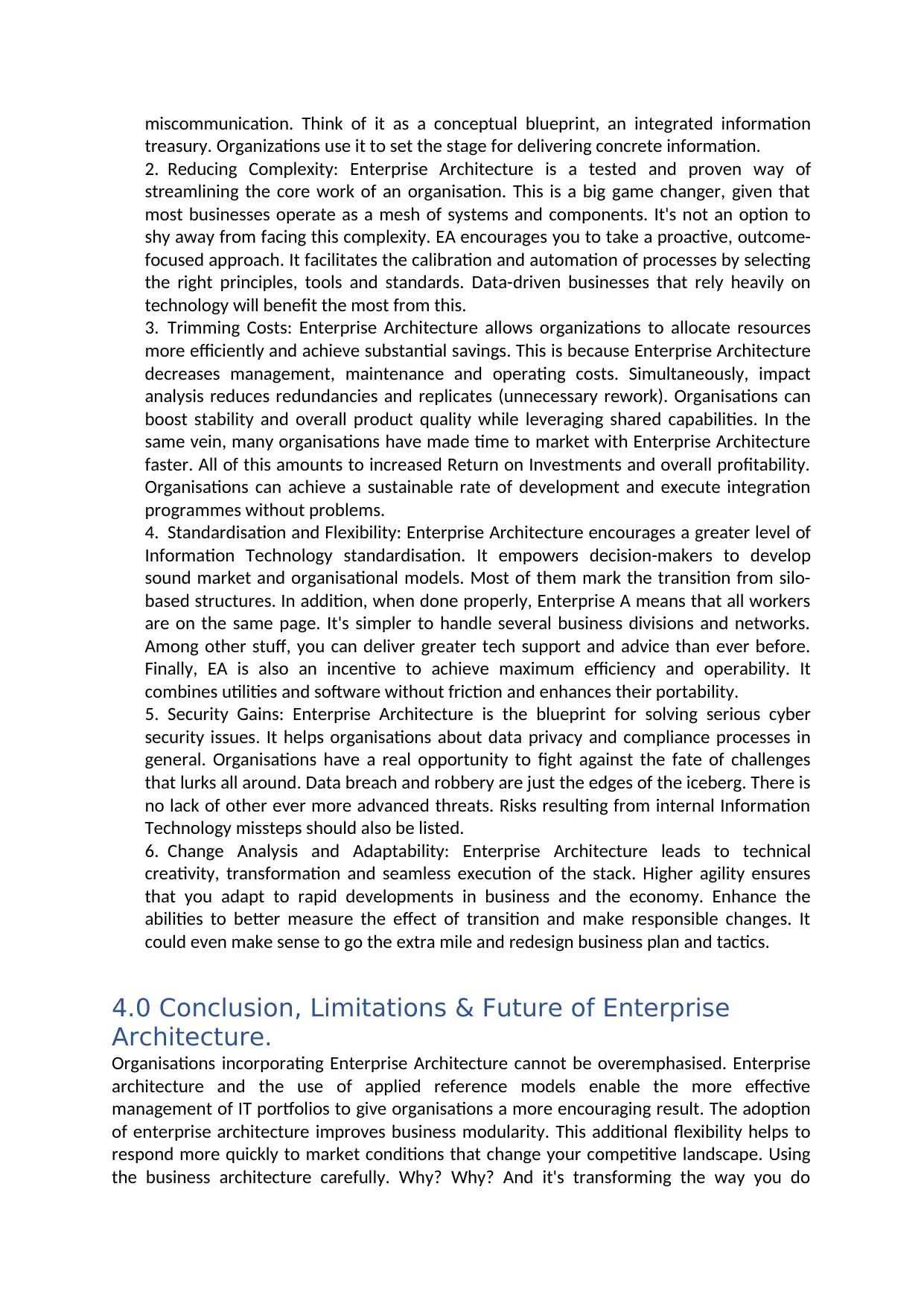
miscommunication. Think of it as a conceptual blueprint, an integrated information
treasury. Organizations use it to set the stage for delivering concrete information.
2. Reducing Complexity: Enterprise Architecture is a tested and proven way of
streamlining the core work of an organisation. This is a big game changer, given that
most businesses operate as a mesh of systems and components. It's not an option to
shy away from facing this complexity. EA encourages you to take a proactive, outcome-
focused approach. It facilitates the calibration and automation of processes by selecting
the right principles, tools and standards. Data-driven businesses that rely heavily on
technology will benefit the most from this.
3. Trimming Costs: Enterprise Architecture allows organizations to allocate resources
more efficiently and achieve substantial savings. This is because Enterprise Architecture
decreases management, maintenance and operating costs. Simultaneously, impact
analysis reduces redundancies and replicates (unnecessary rework). Organisations can
boost stability and overall product quality while leveraging shared capabilities. In the
same vein, many organisations have made time to market with Enterprise Architecture
faster. All of this amounts to increased Return on Investments and overall profitability.
Organisations can achieve a sustainable rate of development and execute integration
programmes without problems.
4. Standardisation and Flexibility: Enterprise Architecture encourages a greater level of
Information Technology standardisation. It empowers decision-makers to develop
sound market and organisational models. Most of them mark the transition from silo-
based structures. In addition, when done properly, Enterprise A means that all workers
are on the same page. It's simpler to handle several business divisions and networks.
Among other stuff, you can deliver greater tech support and advice than ever before.
Finally, EA is also an incentive to achieve maximum efficiency and operability. It
combines utilities and software without friction and enhances their portability.
5. Security Gains: Enterprise Architecture is the blueprint for solving serious cyber
security issues. It helps organisations about data privacy and compliance processes in
general. Organisations have a real opportunity to fight against the fate of challenges
that lurks all around. Data breach and robbery are just the edges of the iceberg. There is
no lack of other ever more advanced threats. Risks resulting from internal Information
Technology missteps should also be listed.
6. Change Analysis and Adaptability: Enterprise Architecture leads to technical
creativity, transformation and seamless execution of the stack. Higher agility ensures
that you adapt to rapid developments in business and the economy. Enhance the
abilities to better measure the effect of transition and make responsible changes. It
could even make sense to go the extra mile and redesign business plan and tactics.
4.0 Conclusion, Limitations & Future of Enterprise
Architecture.
Organisations incorporating Enterprise Architecture cannot be overemphasised. Enterprise
architecture and the use of applied reference models enable the more effective
management of IT portfolios to give organisations a more encouraging result. The adoption
of enterprise architecture improves business modularity. This additional flexibility helps to
respond more quickly to market conditions that change your competitive landscape. Using
the business architecture carefully. Why? Why? And it's transforming the way you do
treasury. Organizations use it to set the stage for delivering concrete information.
2. Reducing Complexity: Enterprise Architecture is a tested and proven way of
streamlining the core work of an organisation. This is a big game changer, given that
most businesses operate as a mesh of systems and components. It's not an option to
shy away from facing this complexity. EA encourages you to take a proactive, outcome-
focused approach. It facilitates the calibration and automation of processes by selecting
the right principles, tools and standards. Data-driven businesses that rely heavily on
technology will benefit the most from this.
3. Trimming Costs: Enterprise Architecture allows organizations to allocate resources
more efficiently and achieve substantial savings. This is because Enterprise Architecture
decreases management, maintenance and operating costs. Simultaneously, impact
analysis reduces redundancies and replicates (unnecessary rework). Organisations can
boost stability and overall product quality while leveraging shared capabilities. In the
same vein, many organisations have made time to market with Enterprise Architecture
faster. All of this amounts to increased Return on Investments and overall profitability.
Organisations can achieve a sustainable rate of development and execute integration
programmes without problems.
4. Standardisation and Flexibility: Enterprise Architecture encourages a greater level of
Information Technology standardisation. It empowers decision-makers to develop
sound market and organisational models. Most of them mark the transition from silo-
based structures. In addition, when done properly, Enterprise A means that all workers
are on the same page. It's simpler to handle several business divisions and networks.
Among other stuff, you can deliver greater tech support and advice than ever before.
Finally, EA is also an incentive to achieve maximum efficiency and operability. It
combines utilities and software without friction and enhances their portability.
5. Security Gains: Enterprise Architecture is the blueprint for solving serious cyber
security issues. It helps organisations about data privacy and compliance processes in
general. Organisations have a real opportunity to fight against the fate of challenges
that lurks all around. Data breach and robbery are just the edges of the iceberg. There is
no lack of other ever more advanced threats. Risks resulting from internal Information
Technology missteps should also be listed.
6. Change Analysis and Adaptability: Enterprise Architecture leads to technical
creativity, transformation and seamless execution of the stack. Higher agility ensures
that you adapt to rapid developments in business and the economy. Enhance the
abilities to better measure the effect of transition and make responsible changes. It
could even make sense to go the extra mile and redesign business plan and tactics.
4.0 Conclusion, Limitations & Future of Enterprise
Architecture.
Organisations incorporating Enterprise Architecture cannot be overemphasised. Enterprise
architecture and the use of applied reference models enable the more effective
management of IT portfolios to give organisations a more encouraging result. The adoption
of enterprise architecture improves business modularity. This additional flexibility helps to
respond more quickly to market conditions that change your competitive landscape. Using
the business architecture carefully. Why? Why? And it's transforming the way you do
Paraphrase This Document
Need a fresh take? Get an instant paraphrase of this document with our AI Paraphraser
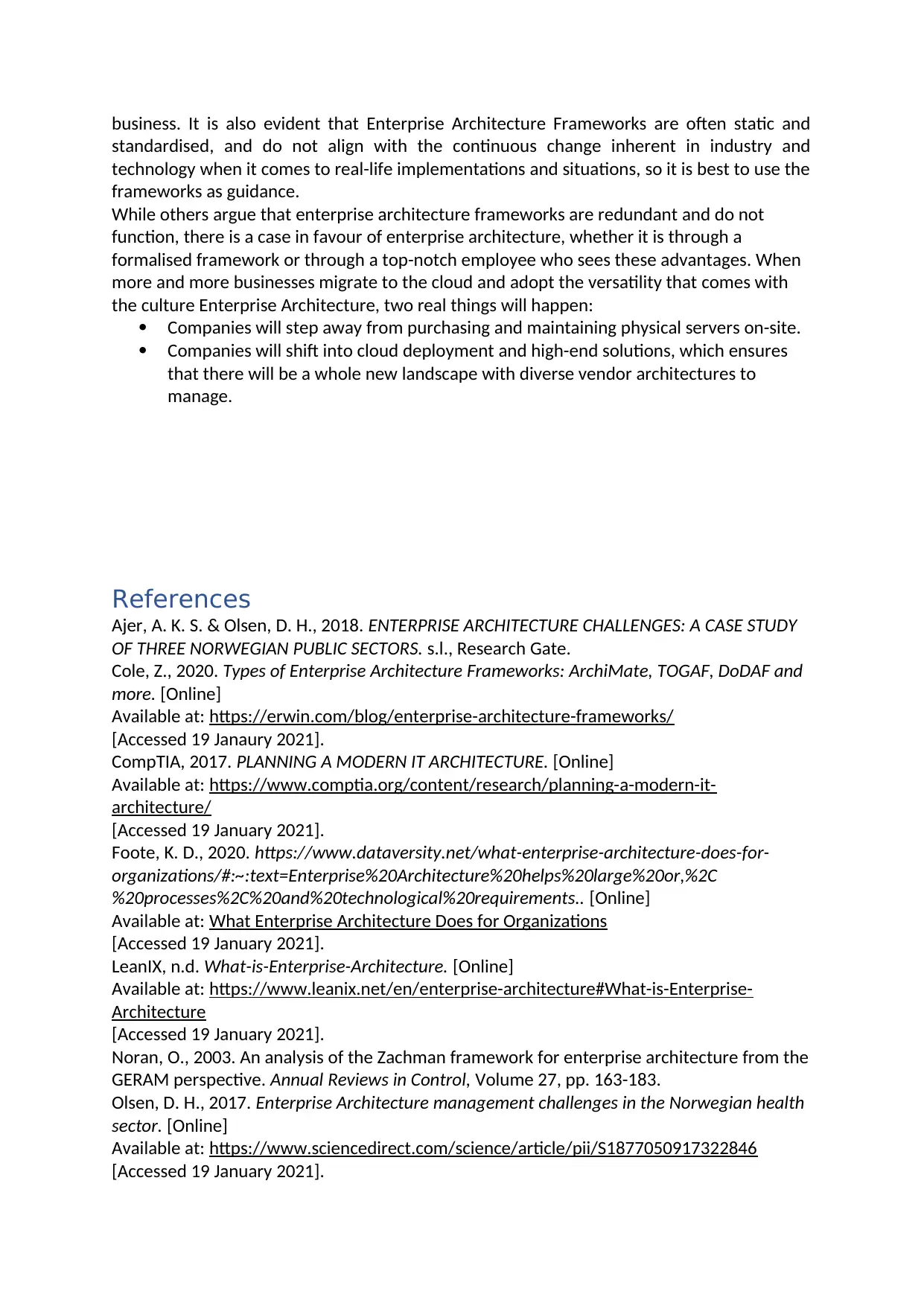
business. It is also evident that Enterprise Architecture Frameworks are often static and
standardised, and do not align with the continuous change inherent in industry and
technology when it comes to real-life implementations and situations, so it is best to use the
frameworks as guidance.
While others argue that enterprise architecture frameworks are redundant and do not
function, there is a case in favour of enterprise architecture, whether it is through a
formalised framework or through a top-notch employee who sees these advantages. When
more and more businesses migrate to the cloud and adopt the versatility that comes with
the culture Enterprise Architecture, two real things will happen:
Companies will step away from purchasing and maintaining physical servers on-site.
Companies will shift into cloud deployment and high-end solutions, which ensures
that there will be a whole new landscape with diverse vendor architectures to
manage.
References
Ajer, A. K. S. & Olsen, D. H., 2018. ENTERPRISE ARCHITECTURE CHALLENGES: A CASE STUDY
OF THREE NORWEGIAN PUBLIC SECTORS. s.l., Research Gate.
Cole, Z., 2020. Types of Enterprise Architecture Frameworks: ArchiMate, TOGAF, DoDAF and
more. [Online]
Available at: https://erwin.com/blog/enterprise-architecture-frameworks/
[Accessed 19 Janaury 2021].
CompTIA, 2017. PLANNING A MODERN IT ARCHITECTURE. [Online]
Available at: https://www.comptia.org/content/research/planning-a-modern-it-
architecture/
[Accessed 19 January 2021].
Foote, K. D., 2020. https://www.dataversity.net/what-enterprise-architecture-does-for-
organizations/#:~:text=Enterprise%20Architecture%20helps%20large%20or,%2C
%20processes%2C%20and%20technological%20requirements.. [Online]
Available at: What Enterprise Architecture Does for Organizations
[Accessed 19 January 2021].
LeanIX, n.d. What-is-Enterprise-Architecture. [Online]
Available at: https://www.leanix.net/en/enterprise-architecture#What-is-Enterprise-
Architecture
[Accessed 19 January 2021].
Noran, O., 2003. An analysis of the Zachman framework for enterprise architecture from the
GERAM perspective. Annual Reviews in Control, Volume 27, pp. 163-183.
Olsen, D. H., 2017. Enterprise Architecture management challenges in the Norwegian health
sector. [Online]
Available at: https://www.sciencedirect.com/science/article/pii/S1877050917322846
[Accessed 19 January 2021].
standardised, and do not align with the continuous change inherent in industry and
technology when it comes to real-life implementations and situations, so it is best to use the
frameworks as guidance.
While others argue that enterprise architecture frameworks are redundant and do not
function, there is a case in favour of enterprise architecture, whether it is through a
formalised framework or through a top-notch employee who sees these advantages. When
more and more businesses migrate to the cloud and adopt the versatility that comes with
the culture Enterprise Architecture, two real things will happen:
Companies will step away from purchasing and maintaining physical servers on-site.
Companies will shift into cloud deployment and high-end solutions, which ensures
that there will be a whole new landscape with diverse vendor architectures to
manage.
References
Ajer, A. K. S. & Olsen, D. H., 2018. ENTERPRISE ARCHITECTURE CHALLENGES: A CASE STUDY
OF THREE NORWEGIAN PUBLIC SECTORS. s.l., Research Gate.
Cole, Z., 2020. Types of Enterprise Architecture Frameworks: ArchiMate, TOGAF, DoDAF and
more. [Online]
Available at: https://erwin.com/blog/enterprise-architecture-frameworks/
[Accessed 19 Janaury 2021].
CompTIA, 2017. PLANNING A MODERN IT ARCHITECTURE. [Online]
Available at: https://www.comptia.org/content/research/planning-a-modern-it-
architecture/
[Accessed 19 January 2021].
Foote, K. D., 2020. https://www.dataversity.net/what-enterprise-architecture-does-for-
organizations/#:~:text=Enterprise%20Architecture%20helps%20large%20or,%2C
%20processes%2C%20and%20technological%20requirements.. [Online]
Available at: What Enterprise Architecture Does for Organizations
[Accessed 19 January 2021].
LeanIX, n.d. What-is-Enterprise-Architecture. [Online]
Available at: https://www.leanix.net/en/enterprise-architecture#What-is-Enterprise-
Architecture
[Accessed 19 January 2021].
Noran, O., 2003. An analysis of the Zachman framework for enterprise architecture from the
GERAM perspective. Annual Reviews in Control, Volume 27, pp. 163-183.
Olsen, D. H., 2017. Enterprise Architecture management challenges in the Norwegian health
sector. [Online]
Available at: https://www.sciencedirect.com/science/article/pii/S1877050917322846
[Accessed 19 January 2021].
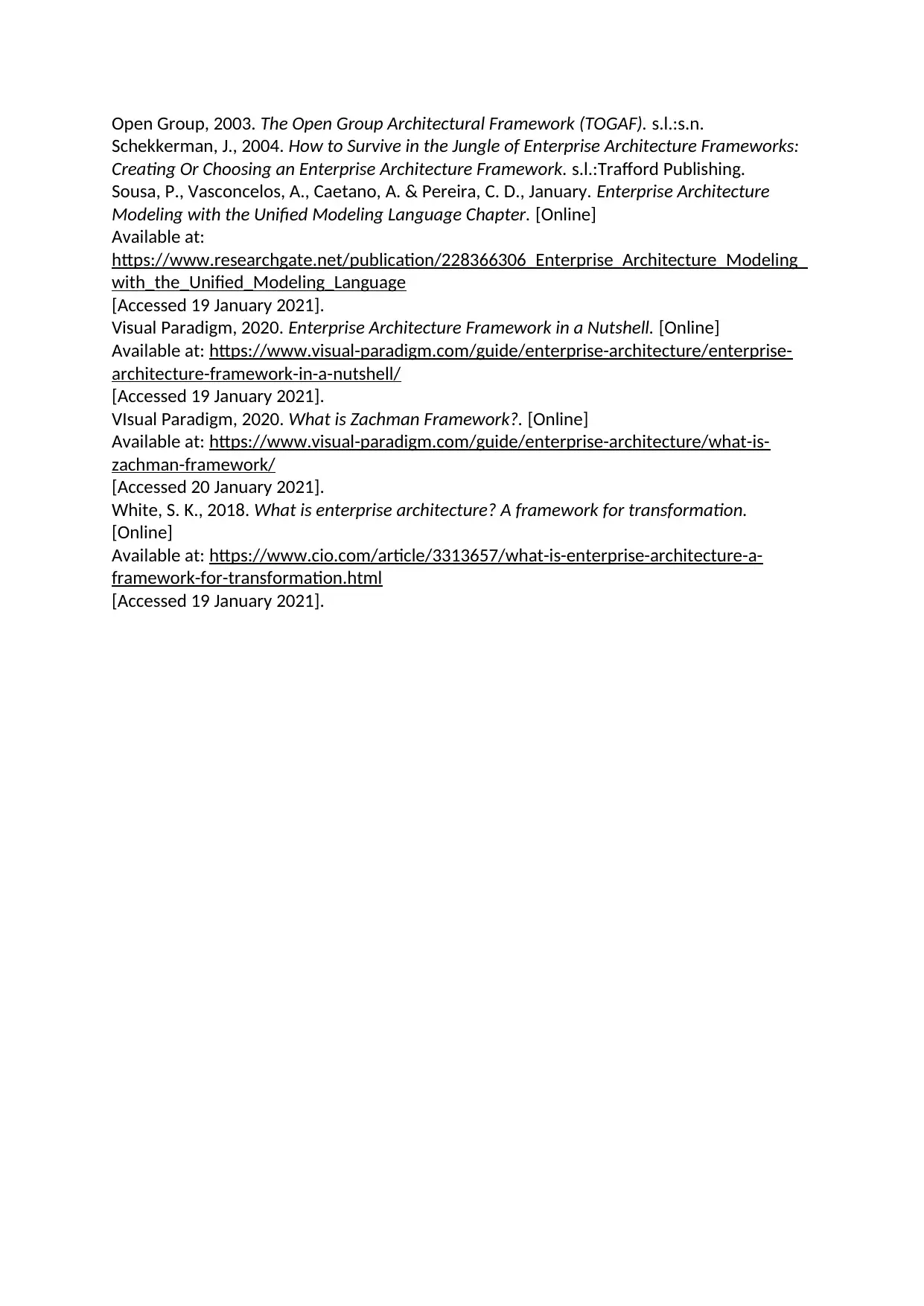
Open Group, 2003. The Open Group Architectural Framework (TOGAF). s.l.:s.n.
Schekkerman, J., 2004. How to Survive in the Jungle of Enterprise Architecture Frameworks:
Creating Or Choosing an Enterprise Architecture Framework. s.l.:Trafford Publishing.
Sousa, P., Vasconcelos, A., Caetano, A. & Pereira, C. D., January. Enterprise Architecture
Modeling with the Unified Modeling Language Chapter. [Online]
Available at:
https://www.researchgate.net/publication/228366306_Enterprise_Architecture_Modeling_
with_the_Unified_Modeling_Language
[Accessed 19 January 2021].
Visual Paradigm, 2020. Enterprise Architecture Framework in a Nutshell. [Online]
Available at: https://www.visual-paradigm.com/guide/enterprise-architecture/enterprise-
architecture-framework-in-a-nutshell/
[Accessed 19 January 2021].
VIsual Paradigm, 2020. What is Zachman Framework?. [Online]
Available at: https://www.visual-paradigm.com/guide/enterprise-architecture/what-is-
zachman-framework/
[Accessed 20 January 2021].
White, S. K., 2018. What is enterprise architecture? A framework for transformation.
[Online]
Available at: https://www.cio.com/article/3313657/what-is-enterprise-architecture-a-
framework-for-transformation.html
[Accessed 19 January 2021].
Schekkerman, J., 2004. How to Survive in the Jungle of Enterprise Architecture Frameworks:
Creating Or Choosing an Enterprise Architecture Framework. s.l.:Trafford Publishing.
Sousa, P., Vasconcelos, A., Caetano, A. & Pereira, C. D., January. Enterprise Architecture
Modeling with the Unified Modeling Language Chapter. [Online]
Available at:
https://www.researchgate.net/publication/228366306_Enterprise_Architecture_Modeling_
with_the_Unified_Modeling_Language
[Accessed 19 January 2021].
Visual Paradigm, 2020. Enterprise Architecture Framework in a Nutshell. [Online]
Available at: https://www.visual-paradigm.com/guide/enterprise-architecture/enterprise-
architecture-framework-in-a-nutshell/
[Accessed 19 January 2021].
VIsual Paradigm, 2020. What is Zachman Framework?. [Online]
Available at: https://www.visual-paradigm.com/guide/enterprise-architecture/what-is-
zachman-framework/
[Accessed 20 January 2021].
White, S. K., 2018. What is enterprise architecture? A framework for transformation.
[Online]
Available at: https://www.cio.com/article/3313657/what-is-enterprise-architecture-a-
framework-for-transformation.html
[Accessed 19 January 2021].
⊘ This is a preview!⊘
Do you want full access?
Subscribe today to unlock all pages.

Trusted by 1+ million students worldwide
1 out of 12
Related Documents
Your All-in-One AI-Powered Toolkit for Academic Success.
+13062052269
info@desklib.com
Available 24*7 on WhatsApp / Email
![[object Object]](/_next/static/media/star-bottom.7253800d.svg)
Unlock your academic potential
Copyright © 2020–2025 A2Z Services. All Rights Reserved. Developed and managed by ZUCOL.





